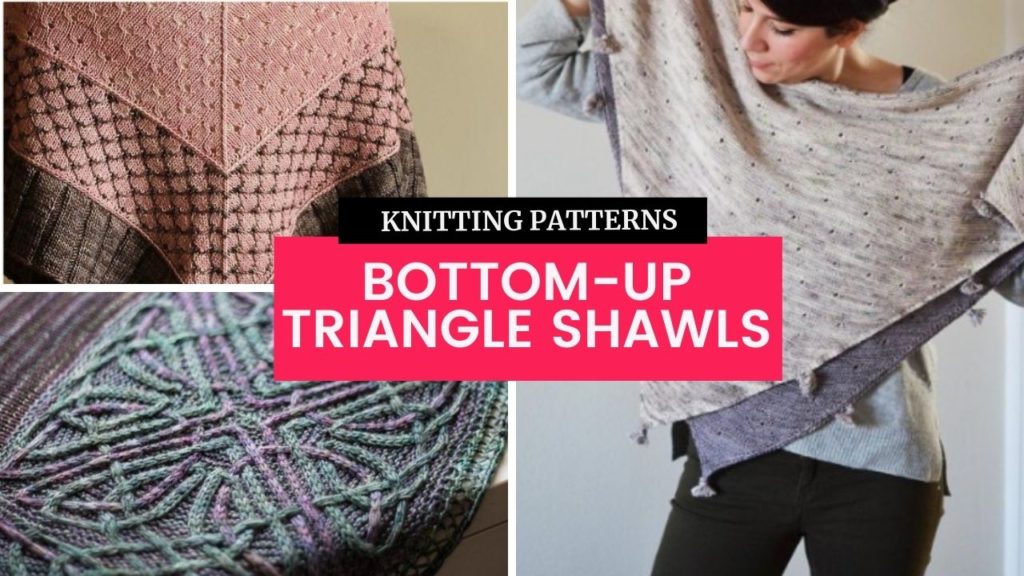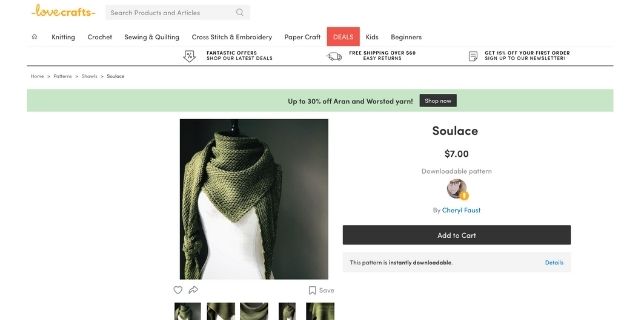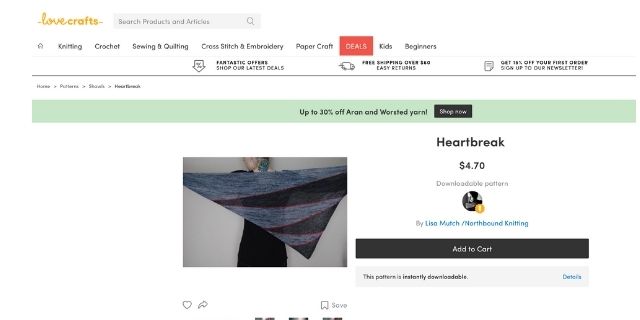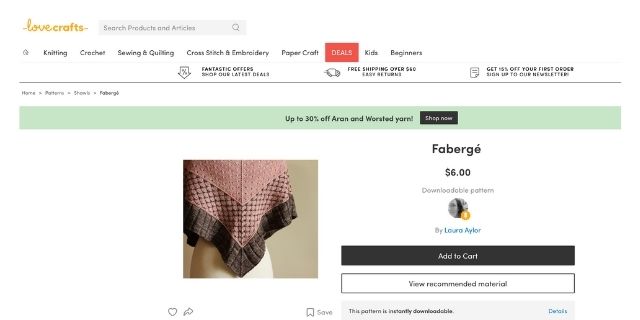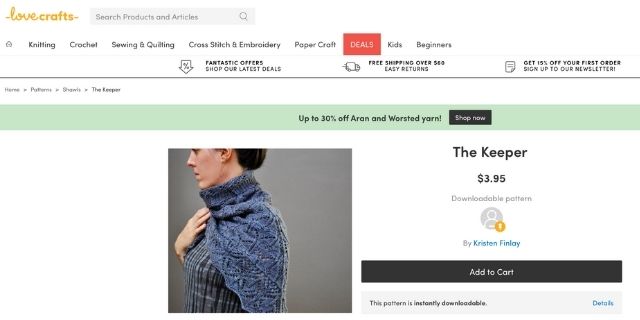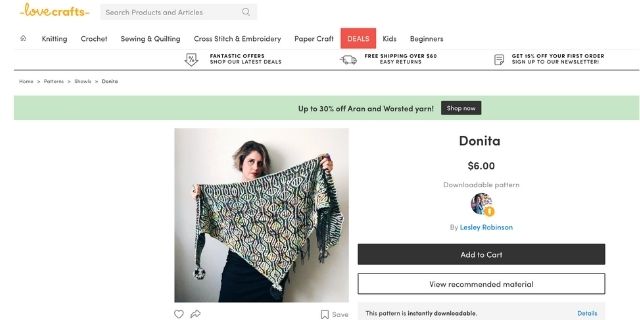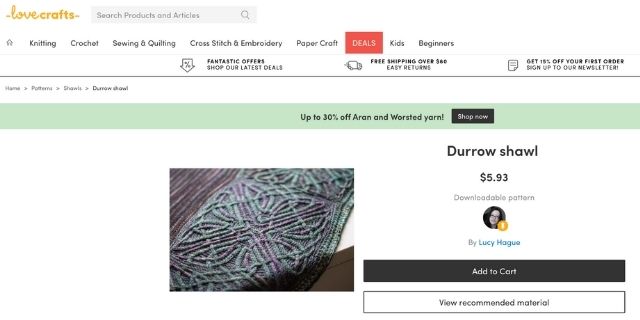Triangle shawls are a popular knitting project. And, while the usual top-down triangle shawls are a first shawl project for many new knitters, a bottom-up triangle shawl knitting pattern can be fun and interesting as well. And, they are usually easier to knit (no special cast on techniques needed). You start by casting on just a few stitches and work increases along the edges to create the triangle shape.
In this article we’ll explore ten different knitting patterns:
- Kari Shawl by Sari Nordlund
- I Smell Snow by Melody Hoffmann
- Soulace by Cheryl Faust
- Nangou by Melanie Berg
- Heartbreak by Lisa Mutch
- Faberge by Laura Aylor
- The Keeper by Kristen Finlay
- Donita by Lesley Robinson
- Arol by Audrey Borrego
- Durrow by Lucy Hague
These ten knitting patterns are all worked using the bottom-up triangle shawl construction. Some are fairly simple (great if you’re a new knitter) and some really play with the bottom-up triangle construction method (which is great for adventurous knitters who want to try something a little different).
If you’ve never knit a bottom-up triangle shawl, one of these knitting patterns is a great place to start. You’ll find links for the patterns as well as recommended yarn to make things a little bit easier.
All of these patterns can be found on Lovecrafts. The links below are affiliate links – if you click through and make a purchase I may receive a small commission at no extra cost to you (see the disclosure policy for more information).
Kari Shawl
The Kari Shawl by Sari Nordlund is definitely easy television knitting. You don’t need to count stitches or rows – just work your increases at each end. There are even options for tassels and pompoms for a bit of fun too. The pattern calls for a DK weight (CYC 3) alpaca yarn – which would be a wonderfully warm and snuggly choice.
Get the pattern: Kari Shawl
Recommended yarn: Plymouth Yarn Baby Alpaca DK
I Smell Snow
I Smell Snow by Melody Hoffmann is another bottom-up triangle Garter stitch shawl that the author calls a ‘modern take on a Shetland hap.’ Along with the relaxing Garter stitch, you’ll find eyelets worked in a gradient fashion for a bit of extra textural interest and a second optional color could be used as well. The pattern also has the option of adding mini tassels as well.
Get the pattern: I Smell Snow
Recommended yarn: Madelinetosh Twist Light
Soulace
Soulace by Cheryl Faust is another relaxing shawl knitting pattern that’s generously sized. We’re leaving Garter stitch behind and using a textured slip-stitch pattern instead along with a decorative picot bind-off. The pattern includes written and charted instructions for the slip-stitch pattern and is simple enough for those who are new to slip-stitch patterns but engaging enough to keep more experienced knitters engaged.
Get the pattern: Soulace
Recommended yarn: Yarn Collective Bloomsbury DK
Nangou
Nangou by Melanie Berg has a casual yet elegant feel and, while it’s worked from the bottom up, the increases rate is changed so you end up with an asymmetrical triangle shawl. Even though the increases change the shape, it’s still worked in simple Garter stitch so it’s still falls within the easy knitting category. There’s also sections of eyelets worked in a contrasting color for a little more visual interest.
Get the pattern: Nangou
Recommended yarn: Cascade Heritage Silk
Heartbreak
Heartbreak by Lisa Mutch, while it follow the basic bottom-up construction, uses short rows and contrasting colors for visual interest (and the pattern is also available in French). This shawl is for a more experienced knitter who wants to experiment with short row shaping and how it’s applied to shawl shaping. You’ll need three different colors for this shawl (it’s a great way to stash dive in your favorite superwash fingering yarns).
Get the pattern: Heartbreak
Recommended yarn: Cascade Heritage Solids
Faberge
Faberge by Laura Aylor is a beautiful, textured shawl worked in two complementary colors. It features a simple textured section, a slip-stitch colorwork section (with some beading), and the bottom border is an adorable pleated edge that gives it a decidedly feminine touch. It’s not exactly mindless knitting but for such a beautiful shawl, the careful attention is worth the effort. The pattern also includes three different sizing options: a kerchief size, a medium shawl, and a large shawl.
Get the pattern: Faberge
Recommended yarn: Madelintosh Tosh Merino Light
The Keeper
The Keeper by Kristen Finlay begins by casting on the full amount of stitches and working a lace edging (which is charted) along the bottom. Then, the lace patterning is continued while decreases are worked along both edges and along the center to create the shape. The right and left sides are grated together to finish the Garter stitch band. This is a beautiful choice for those who love lace shawls and want to give bottom-up shawl knitting construction a try.
Get the pattern: The Keeper
Recommended yarn: Berroco Ultra Alpaca Light
Donita
Donita by Lesley Robinson is a thick, cozy shawl with an all-over diamond and ladder lace patterning using two-color brioche. The shawl beings with a geometric diamond stitch pattern that grows as the shawl takes shape. Choose two high-contrast yarns to show the brioche stitch patterning to it’s full effect (a solid paired with a variegated or tonal yarn would also be a great choice).
Get the pattern: Donita
Recommended yarn: Madelinetosh Tosh DK
Arol
Arol by Audrey Borrego is a large bottom-up triangle shawl that features a lace and cable panel at the center surrounded by Garter stitch. It begins with an I-cord cast on (with I-cord edging used along both sides) and simple increases at the edges and some additional short-row shaping is used to elongate the wingspan. The pattern includes video tutorials as well as charts and written instructions for the cable and lace panel (and the pattern is also available in French).
Get the pattern: Arol
Recommended yarn: Madelinetosh Tosh Merino Light
Durrow
Durrow by Lucy Hague is worked a little bit differently than the other shawls in this article. The border is worked first, in a series of squares that are worked in the round. When the border is complete, stitches are picked up along the inside and the shawl body is worked upwards towards the neck, using simple decreases to create the triangle shape. It’s completed with an I-cord edging and a lace edging is worked along the outer edge of the border. This pattern is for more advanced knitters who are comfortable with complex cables.
Get the pattern: Durrow
Recommended yarn: Malabrigo Sock
How to Knit a Bottom-Up Triangle Shawl
Knitting a triangle shawl from the bottom tip to the top (long edge) is very easy.
- Cast on 3 stitches.
- Set-up row: Knit 1, work an increase, knit 1, work an increase, knit 1.
- (Wrong Side) Knit all stitches (for a Garter stitch shawl) or Purl all stitches (for a Stockinette stitch shawl).
- (Right Side) Knit 1, work an increase, knit to last stitch, work an increase, knit 1.
Repeat the two rows until the shawl is as large as you want. This is a very basic pattern and can be changed in many ways to create a truly unique shawl (as you can see from the ten patterns described above). Add stitch patterns, change the increase rate, add different colors – there are so many ways to adjust this simple shape.
The easiest change to make is to change the rate of increase which will affect the width and depth of the shawl. For a shawl with a wider wingspan (and shallower triangle shape) add increases on wrong-side rows too. This is a great option for those who don’t like deep triangle shawls but like to really wrap themselves up in a wide shawl.
This is also a great construction method for using up all your yarn (which is really nice when you have one really precious skein and want to use up every last bit of it). Just keep knitting until you have just enough to bind off. When you’re getting low, measure out about three yards and put a slipknot at that point. As you knit, you’ll be able to see how quickly you reach that three-yard slipknot and can use that to estimate how much you’ll need to finish each row.
Recommended Reading: How to Knit a Bottom up Triangle Shawl
You can learn all about the bottom-up triangle shawl construction in this video:
One other note: If you’re working a Stockinette shawl (knitting on the right side rows and purling on the wrong side rows) you’ll want to add a few stitches of Garter stitch or another non-rolling edge to both sides as Stockinette as a tendency to curl.
If you’re new to knitting bottom-up triangle shawls, try one of these knitting patterns! To learn more about shawl knitting, take a look at the resources and articles linked below.
Shawl Knitting Resources
- Custom Shawls for the Curious & Creative Knitter by Kate Atherley and Kim McBrien Evans (available on Amazon)
- Knit Shawls & Wraps in One Week by Marie Greene (available on Amazon)
- The Magic of Shetland Lace Knitting by Elizabeth Lovick (available on Amazon)
- Knitting Modular Shawls, Wraps & Stoles by Melissa Leapman (available on Amazon)
More Articles about Knitting Shawls
- How to Knit a Triangle Shawl Sideways from Tip to Tip
- 10 Knitting Patterns for Sideways Triangle Shawls (knit tip to tip)
- 12 Beginner Shawl Knitting Patterns
